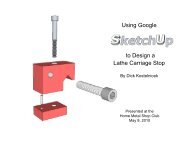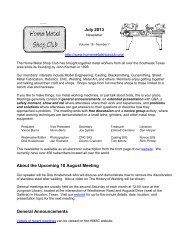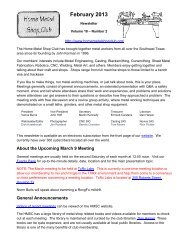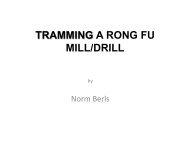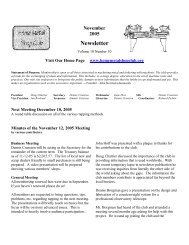October 2009 - Home Metal Shop Club
October 2009 - Home Metal Shop Club
October 2009 - Home Metal Shop Club
You also want an ePaper? Increase the reach of your titles
YUMPU automatically turns print PDFs into web optimized ePapers that Google loves.
<strong>October</strong> <strong>2009</strong><br />
Newsletter<br />
Volume 14 - Number 10<br />
http://www.homemetalshopclub.org/<br />
Since its founding by John Korman in 1996, The <strong>Home</strong> <strong>Metal</strong> <strong>Shop</strong> <strong>Club</strong> has brought together metal<br />
workers from all over the Southeast Texas area.<br />
Our members’ interests include Model Engineering, Casting, Blacksmithing, Gunsmithing, Sheet <strong>Metal</strong><br />
Fabrication, Robotics, CNC, Welding, <strong>Metal</strong> Art, and others. Members always like to talk about their<br />
craft and shops. <strong>Shop</strong>s range from full machine shops to those limited to a bench vise and hacksaw.<br />
If you like to make things, run metal working machines, or just talk about tools, this is your place.<br />
Meetings generally consist of a presentation with Q&A, followed by show and tell where the members<br />
can share their work and experiences.<br />
President<br />
Vance Burns<br />
Vice President<br />
John Hoff<br />
Treasurer<br />
Emmett Carstens<br />
Secretary<br />
Dick Kostelnicek<br />
Librarian<br />
Dan Harper<br />
Webmaster<br />
Dick Kostelnicek<br />
Photographer<br />
Jan Rowland<br />
CNC SIG<br />
Dennis Cranston<br />
Casting SIG<br />
Tom Moore<br />
Novice SIG<br />
Rich Pichler<br />
About the Upcoming November 14 Meetings<br />
We’re meeting at the Freed-Montrose library in Houston at 1:00 p.m. A business meeting will<br />
convene at the snack shop next to the Freed-Montrose Library entrance at 11:30 p.m. Jan<br />
Rowland will talk on Ball and ACME screws in CNC and Machines that I Cobbled Together. Visit<br />
http://www.homemetalshopclub.org/events.html for details about upcoming events.<br />
Recap of the <strong>October</strong> 10 Regular Meeting
<strong>October</strong> <strong>2009</strong> - <strong>Home</strong> <strong>Metal</strong> <strong>Shop</strong> <strong>Club</strong> Newsletter - V.14 No.10<br />
Twenty-two members attended the 1:00 p.m. meeting at the Looscan library. President Vance<br />
Burns presided. Guests included Dave Rutledge, Pete Bull, Nick Reyner, and Bill Peck (a<br />
blacksmith). A request was made for members to submit their metal working capabilities and<br />
willingness to help others (fee or gratis) to be put on a new club web page, All interested<br />
members should contact the webmaster.<br />
Presentation<br />
Bill Swann and Adam<br />
Hampton talked about<br />
the economic feasibility<br />
of running Bill’s electric<br />
car from a primary<br />
source of a tracking<br />
photo-voltaic array in<br />
Houston TX.<br />
Their analysis included<br />
all investment costs<br />
through the savings by<br />
not using gasoline. They<br />
determined that a 30-mile per day range could be supported by charging batteries at night from<br />
the power grid and reverse powering the grid from their photo-voltaic array during the day.<br />
Adam Hampton demonstrated his open-loop tracking motor and electronics driving the array.<br />
Show & Tell<br />
Joe Williams described a Glass Blowing Lathe (see article below) and showed his watch closing<br />
jig consisting of two hollowed-out aluminum cups that are used with a C-clamp to press shut a<br />
watch case.<br />
Dick Kostelnicek demonstrated how to cut 1/8-inch diameter<br />
copper tubing by scoring it with a pocketknife and breaking it with<br />
the help a short length of overriding stiff tubing (right).<br />
Dan Harper showed his extractor for broken taps (below).<br />
Mike Winkler brought his homemade lathe center rest that uses<br />
ball bearing work supports (right).<br />
2
<strong>October</strong> <strong>2009</strong> - <strong>Home</strong> <strong>Metal</strong> <strong>Shop</strong> <strong>Club</strong> Newsletter - V.14 No.10<br />
Ed Gladkowski showed some very small injection molded model<br />
parts that he cast (below). He used molten ZA12 metal forced<br />
into a steel mold with the aid of steam generated from a “wet<br />
blanket” cover plate placed over the molten metal revervoir.<br />
Articles<br />
Making a Slugger<br />
By Vance Burns<br />
Louisville Kentucky is the home of the Hillerich & Bradsby Company, better known as the<br />
manufacturers of the “Louisville Slugger”. This is slugger city; as you walk down the streets<br />
there are cast bronze baseball bats set into the sidewalk, tipped against a<br />
nearby building, each one a scale model of a unique bat design with a bronze<br />
home plate describing the bat's history. Quite charming.<br />
Upon reaching the plant, the first thing you notice is a seven-story bat, tipped<br />
against the building. The scaled replica is something in it's own right;<br />
constructed of A36 steel, it stands 120 feet high, 9 feet wide at the base and<br />
weighs 68,000 pounds. If it were full of Louisville pride, it would hold 30,000<br />
gallons.<br />
I'm not much of a ball fan, but I can attest there is enough baseball<br />
memorabilia displayed to warm the heart of any sand lot aficionado. My interests lie in the<br />
manufacturing process.<br />
The outer sanctum of the plant held all the baseball<br />
mementos, and just at the plant tour entrance is a static<br />
replica of how the shop<br />
used to operate. The<br />
future bat billets were<br />
delivered as logs, which<br />
were cut to length and<br />
riven, split in eighths,<br />
resulting in the long<br />
triangular shaped pieces<br />
you see at left. The lathes were really interesting; they were<br />
called back-knife lathes, but these didn't have a “back-knife”<br />
nor were they technically a lathe as we think of one, rather they had what I would call a “Profile<br />
3
<strong>October</strong> <strong>2009</strong> - <strong>Home</strong> <strong>Metal</strong> <strong>Shop</strong> <strong>Club</strong> Newsletter - V.14 No.10<br />
Cutter”. As you can see, a large fixture supports hundreds of cutting blades, aligned to cut a<br />
full-length bat with one pass at the billet. These individual blades were identical to the blades on<br />
cabinetmakers’ hand-plane; small, flat, rectangles. The fixture provided mounting points and the<br />
blades were bolted to the apparatus, which provided approximate positioning. Retargeting and<br />
realignment must have been a nightmare. Now imagine placing the triangular log segment<br />
between the spindles, turning it at a high speed, and easing it into the counter-rotating fixture...<br />
Danger Will Robinson!<br />
Once in the plant<br />
proper, you are then<br />
taken into the<br />
woodturning lathe<br />
area, where manual<br />
turning is<br />
demonstrated. They<br />
then take you to the<br />
automated turning<br />
area, and explain how<br />
the Hemple Lathes were brought into the business, eliminating the 30 minute manual process,<br />
producing a profiled bat every thirty seconds. The cutter/vac assembly slides out of the way,<br />
back over the spindle, a billet is automatically centered, and then the cutter slides across the<br />
billet, cutting the bat in one pass as it follows a plate steel template. Professional bats are<br />
turned in the same fashion, however they are produced singly on a CNC system. Amazingly,<br />
little sawdust hits the floor, as the shop is surprisingly clean, with all of the collected waste going<br />
to Maine turkey farmers for bedding. The roughed bat is sent to the<br />
automated sanding systems, and then given the company brand. Ash bats<br />
are branded; Maple bats are labeled, being too structurally brittle to allow a<br />
brand. Aluminum Bats are manufactured in California.<br />
Glass Blowing Lathe<br />
By J. R. Williams<br />
I finished making a dual headstock glass<br />
blowing lathe. Two slow speed stepper<br />
motors are fed by a common signal<br />
source so the two timing belt driven<br />
headstocks are in synch. Headstocks,<br />
chucks, and lathe bed were all made by<br />
Taig Corp. Both headstocks are mounted<br />
on beveled mounting plates attached to<br />
the large base block and the cross slide.<br />
There is a rear mounted carbon gage<br />
block that is pressed against the softened<br />
glass with a profile specific to the part<br />
being formed. The gage block is pivoted<br />
and swings out of the way while heating<br />
the glass. The machine is intended for<br />
making decorative oil lamp globes about<br />
1-1/2 inch diameter and six inches long.<br />
4
<strong>October</strong> <strong>2009</strong> - <strong>Home</strong> <strong>Metal</strong> <strong>Shop</strong> <strong>Club</strong> Newsletter - V.14 No.10<br />
AWG vs. dB<br />
By Dick Kostelnicek<br />
Most mechanics know that decreasing the American Wire Gauge number (AWG) by 6 units<br />
doubles wire diameter. For example, #8 wire (0.1285 inch) is twice the diameter of #14 (0.0641<br />
inch). Decrease it by 3 units and cross sectional area doubles. Now, change hats! In an<br />
electrical circuit of constant resistance, an increase of 6 dB (decibels) means that both voltage<br />
and current double. A 3 dB increase doubles the consumed power. All those 3s and 6s for<br />
doubling… what’s the connection between AWG # size and the dB scale? The mechanic and<br />
electrician in us need reconciliation.<br />
Traditionally, we’ve thinned wire by drawing it through a succession of smaller and smaller dies.<br />
The AWG’s # size represents how many times the wire has been drawn. It starts with #0, a<br />
metal bar about 5/16-inch D. After two draws, it becomes #2 wire, 1/4-inch D. When we<br />
compare the wire diameters of any two adjacent gauge sizes, say a #5 and #6, we find that the<br />
ratio of diameters is 0.891. Each draw of the wire reduces the diameter by about 11%. The<br />
reduction in cross sectional area is 0.793 (the square of the diameter ratio) or 21%. You can<br />
verify this from a Circular Mill table (1 CM = area of a circular wire of 0.001-inch diameter.). The<br />
drawing process conserves metal volume. Hence, each draw elongates a wire by the factor<br />
1.261 (the reciprocal of the area reduction) or by 26%.<br />
Plot wire diameter vs. gauge size on a semi-log chart and you get a straight line. That means<br />
that the AWG system is logarithmic or naturally scaled. Said another way, a wire’s percentage<br />
growth or shrinkage depends only on the change of gauge # and not on its original diameter. An<br />
elephant and a mouse both eat one gauge # (5%) of their body weight each day. The pounds<br />
they put on, however, are grossly different.<br />
1<br />
American Wire Gauge<br />
0.1<br />
Diameter (in.)<br />
0.01<br />
0.001<br />
OO 2 5 8 11 14 17 20 23 26 29 32 35 38<br />
AWG #<br />
5
<strong>October</strong> <strong>2009</strong> - <strong>Home</strong> <strong>Metal</strong> <strong>Shop</strong> <strong>Club</strong> Newsletter - V.14 No.10<br />
Have we skipped over the dB stuff? Hardly! Recall that Alexander Graham Bell’s daughter had a<br />
hearing problem. He showed great interest in the connection between perceived sound level<br />
changes and the acoustic pressure acting on the eardrum. The gauge unit for a 10-fold increase<br />
in sound power was named in his honor, the Bell. Now, one Bell is a big change. A more familiar<br />
gauge is 10 times smaller, the decibel or dB (derived from the grammatically mangled deci-Bell).<br />
One dB is close to a just perceptible change in sound level.<br />
The dB scale is just another gauge. Its dB value represents the amount of electricity relative to a<br />
base value, just as the AWG # expresses a wire’s size relative to a #0 wire. Both gauges report<br />
the logarithm of the ratio of the base component to the item of concern. The base (starting<br />
value) for the AWG is the #0 wire with diameter 0.3249 inches and area 105,531 CM. The base<br />
for the electrical scale is 0 dB, represented by 1-milliwatt dissipated in a 600-ohm circuit having<br />
a voltage of 775-millivolts.<br />
Wire cross sectional area and electrical power play similar roles in their respective gauges.<br />
Changes in wire diameter behave like variations in voltage or current.<br />
Here’s one last observation. AWG #’s increase as wire diameter decreases. The dB scale is the<br />
opposite, voltage, current, and Db values all change in the same direction. But, that’s just a<br />
matter of taking the logarithm of a ratio or its reciprocal.<br />
Anyone still awake!<br />
6



